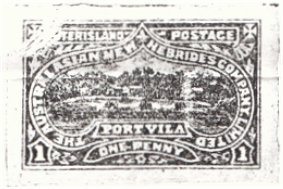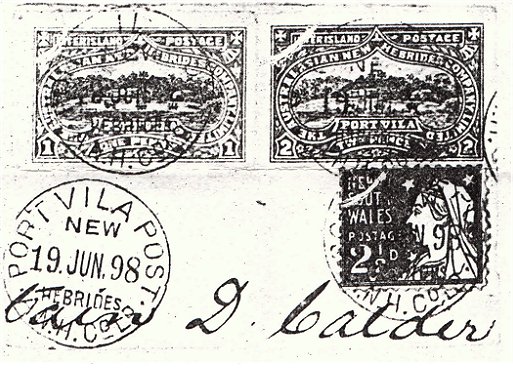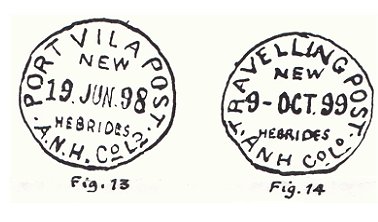A company called the "Australasian New Hebrides Company Ltd." was
registered in 1887. This was a British Company formed with the object of
working trading stations in the New Hebrides and with exporting produce
of all kinds and generally exploiting the Islands.
The New Hebrides were, of course, neutral ground, jointly under the British
and French Governments, but, contrary to the arrangements that
were made later, the two Governments were at that time
confining their powers to policing and criminal matters.
The Australasian New Hebrides Company, being the only British
Company with interests in the Islands, were given a very free hand and
allowed to control all commercial operations, being looked on by the
New South Wales Government and the residents in the group, as likely to
further British interests there.
This Company ran their own steamer as far back as 1892 among the
Islands and to and from the mainland, both for their own use and for the
general carrying of cargo, passengers and mails and this service was
actually subsidised by the Governments of Victoria and New
South Wales, until 1894. From this date on the Company ran a direct
steamer service between Port Vila and Sydney every three weeks which
connected up with a second boat which ran between the various
islands, picking up and delivering cargo, passengers and mails, during
the time that the other boat was running to and from the mainland.
In 1897 the Australasian New Hebrides Company decided to issue
stamps to pay the carriage on letters between the two ports. These
consisted of a 1d. and 2d. value and came into definite use on June 1st of
that year. These same stamps also served for postage between the
Islands but, when used on the main route to or from Sydney the 2½d. New
South Wales stamp, to pay the collection or delivery charges in New
South Wales had to be used in addition.
The various ports of call were as follows:
Aneityum Island - Anelgahat and Port Patrick.
Aniwa Island - Aniwa.
Aoba Island - Lungauna.
Aurora Island - Lakarere.
Epi Island, - Drummond Bay, White Spot Point, Ringdove Bay, Moussu's,
Foreland, Burumba and Diamond Bay.
Erromanga Island - Dillons Bay, Potemia Bay.
Espiritu Island - Pallier and Stephens.
Futuna Island - Futuna.
Mai Island - Mai.
Nguna Island - Nguna.
Pentecost Island - North Pentecost, Trucchi's, Louworbot and Martellis.
Tanna Island - Fijian, Kwammera, Port Resolution, White Sand, Lenelagus,
Weasisi and Lauanbukat.
Tongariki Island - Tongariki.
Tongoa Island - Tongoa.
Sandwich Island - Vila, Etorna, Metensa Bay and Undine Bay.
Vanna Lava Island - Port Patterson.
They also called at the Islands of Ranon, Dip Point, Lonowei, Taviak,
Ambryn and the Santa Cruz, Banks' and Torres Groups.
POSTAL RATES.
The inter-island rates of postage were as follows:
Letters-up to ½ oz. 1d., and 1d. for every additional ½ oz.
Packets and Magazines- up to 4 oz. 1d. and 1d. for every additional 4 oz.
or fraction thereof.
Parcels- up to 8 oz. 1d.-and 1d. for every additional 8 oz. or fraction thereof.
Newspapers 1d.
Registration 2d.
POSTAGE STAMPS
The stamps were lithographed by John Sands & Co. at Sydney to the
design of A. F. Basset Hull. The stamps were actually issued,
according to a contemporary report, on March 17th, 1897, hut we find
postmarks as early as March 1896, which seems to show that there was
probably some error in the first report.

The design - see illustration - consists of a view of Port Vila with "The
Australasian New Hebrides Company Limited" in a label over it. The paper
was white wove, unwatermarked, and the stamps were rouletted.
The 1d. has the central view in black, the rest of the design being in mauve.
The 2d. has the cen-tre in blue and the rest of the design in brown. The
shades of the 1d. vary from a pale rosy mauve to almost a red-lilac, while
the 2d. varies from a pale brown to a yellow-brown.
While the size of the design of the 1d. is 21¾ mm x 34½ mm,
that of the 2d. is slightly larger vertically, being 22¼ mm x 34½ mm.
The actual format of the stamps varies rather more considerably inter-se, due to the
rouletting machine used. The largest format we have seen in both values is
27½ mm high, 40¾ mm wide, while the smallest dimensions have been
26½ mm high and 39½ mm wide. In fact there appear to be tour different
formats.

Although these stamps were in the nature of a private local post, very
similar to the stamps of St. Thomas - La Guiara, the stamps of Samoa and
the "Fiji Times," or the stamps of the Company on Christmas Island, there
is no reason to suppose that there was any speculative element about
their issue and the Company rigorously refused to supply
"cancelled to order" specimens.
At the same time, while these stamps were only of use among the Islands
and to and from the Mainland, they undoubtedly did full postal use in the
same way as any Government issue.
POSTMARKS.
Two cancelling stamps were in use. The first in use at the Company's
Head Office at Port Vila, reads, PORT VILA-POST at top with
."A.N.H.Co.Ld" at foot of circle. Within the circle at top is NEW, then
the full date below in a single line across the centre, with, below,
HEBRIDES. This is always in black. (See Plate 11. Fig.13).
The second cancelling stamp, in use on the interisland boat, reads at top
TRAVELLING POST, the rest of the postmark being the same. This is
found usually in black, but occasionally in vio-let. (See Plate 11.
Fig.14).
The latest date we have seen is 9/8/1899. (typo? 9 Oct 1899 Roland Klinger)
In view of the rather long period that these stamps were in use, it is curious
that more used cop-ies, especially on cover, are not seen. We illustrate the
use of the two values with a 2½d. stamp of N .S. W. (Die 2) on a
registered cover from Port Vila, the N.S.W. stamp having been cancelled
with the PORT VILA POST postmark at time of departure.
SALE OF REMAINDERS.
In 1900 The Australasian New Hebrides Company agreed to
abandon the use of their own stamps on entering into a contract with the
Australian Post Office to carry the mails.
As late as September 1912, the remainders were put up for sale by
tender by Messrs. Burns, Philip and Co. of Sydney, the tenders, on which
a deposit of 5&proz; bad to be paid, were to be opened on March 1st , 1913.
Up to the time of the sale, none of the stamps bad ever been sold below
face value. The total remainders sold were 140,000 of the 1d. and 94,000
of the 2d.

|


